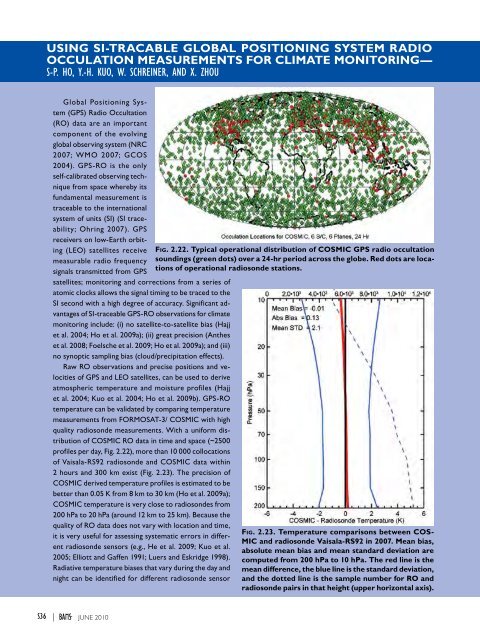Create successful ePaper yourself
Turn your PDF publications into a flip-book with our unique Google optimized e-Paper software.
US<strong>IN</strong>G SI-TRACABLE GLOBAL POSITION<strong>IN</strong>G SYSTEM RADIOOCCULATION MEASUREMENTS FOR <strong>CLIMATE</strong> MONITOR<strong>IN</strong>G—S-P. Ho, Y.-H. Kuo, W. Schreiner, and X. ZhouGlobal Positioning System(GPS) Radio Occultation(RO) data are an importantcomponent of the evolvingglobal observing system (NRC2007; WMO 2007; GCOS2004). GPS-RO is the onlyself-calibrated observing techniquefrom space whereby itsfundamental measurement istraceable to the internationalsystem of units (SI) (SI traceability;Ohring 2007). GPSreceivers on low-Earth orbiting(LEO) satellites receivemeasurable radio frequencysignals transmitted from GPSsatellites; monitoring and corrections from a series ofatomic clocks allows the signal timing to be traced to theSI second with a high degree of accuracy. Significant advantagesof SI-traceable GPS-RO observations for climatemonitoring include: (i) no satellite-to-satellite bias (Hajjet al. 2004; Ho et al. <strong>2009</strong>a); (ii) great precision (Antheset al. 2008; Foelsche et al. <strong>2009</strong>; Ho et al. <strong>2009</strong>a); and (iii)no synoptic sampling bias (cloud/precipitation effects).Raw RO observations and precise positions and velocitiesof GPS and LEO satellites, can be used to deriveatmospheric temperature and moisture profiles (Hajjet al. 2004; Kuo et al. 2004; Ho et al. <strong>2009</strong>b). GPS-ROtemperature can be validated by comparing temperaturemeasurements from FORMOSAT-3/ COSMIC with highquality radiosonde measurements. With a uniform distributionof COSMIC RO data in time and space (~2500profiles per day, Fig. 2.22), more than 10 000 collocationsof Vaisala-RS92 radiosonde and COSMIC data within2 hours and 300 km exist (Fig. 2.23). The precision ofCOSMIC derived temperature profiles is estimated to bebetter than 0.05 K from 8 km to 30 km (Ho et al. <strong>2009</strong>a);COSMIC temperature is very close to radiosondes from200 hPa to 20 hPa (around 12 km to 25 km). Because thequality of RO data does not vary with location and time,it is very useful for assessing systematic errors in differentradiosonde sensors (e.g., He et al. <strong>2009</strong>; Kuo et al.2005; Elliott and Gaffen 1991; Luers and Eskridge 1998).Radiative temperature biases that vary during the day andnight can be identified for different radiosonde sensorFig. 2.22. Typical operational distribution of COSMIC GPS radio occultationsoundings (green dots) over a 24-hr period across the globe. Red dots are locationsof operational radiosonde stations.Fig. 2.23. Temperature comparisons between COS-MIC and radiosonde Vaisala-RS92 in 2007. Mean bias,absolute mean bias and mean standard deviation arecomputed from 200 hPa to 10 hPa. The red line is themean difference, the blue line is the standard deviation,and the dotted line is the sample number for RO andradiosonde pairs in that height (upper horizontal axis).S36 | juNE 2010
















